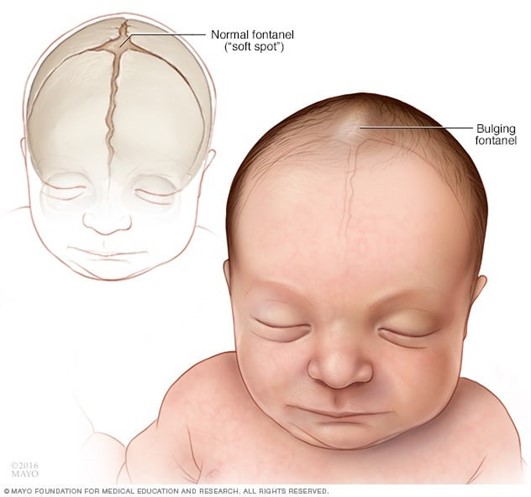A nurse is assessing an 11-month-old infant. Which of the following manifestations is associated with a CNS infection?
Oliguria.
Jaundice.
Bulging fontanel.
Negative Brudzinski sign.
The Correct Answer is C
A bulging fontanel is a manifestation associated with a CNS infection in an 11- month-old infant.
A bulging fontanel can be a sign of increased intracranial pressure, which can
occur with meningitis or encephalitis, both of which are types of CNS infections.
Choice A is incorrect because oliguria, or decreased urine output, is not typically associated with a CNS infection.
Choice B is incorrect because jaundice, or yellowing of the skin and eyes, is not typically associated with a CNS infection.
Choice D is incorrect because a negative Brudzinski sign would indicate that there is no neck stiffness, which would be an unlikely finding in a CNS infection.

Nursing Test Bank
Naxlex Comprehensive Predictor Exams
Related Questions
Correct Answer is B
Explanation
A calcium level of 8.0 mg/dL is below the normal range for adults, which is 8.8 to 10.4 mg/dL.
This condition is known as hypocalcemia and can cause muscle spasms and aches.
Choice A is incorrect because a positive Chvostek’s sign, not a negative one, is a clinical sign of hypocalcemia.
Choice C is incorrect because dry, sticky mucous membranes are not a symptom of hypocalcemia.
Choice D is incorrect because polyuria (frequent urination) is a symptom of hypercalcemia (high calcium levels), not hypocalcemia.
Correct Answer is A
Explanation
The correct answer is choice a. Reposition the child every 2 hr.
Choice A rationale:
Repositioning the child every 2 hours is essential to prevent complications such as pressure ulcers and to promote comfort and circulation.
Choice B rationale:
Removing the traction boot during baths is not recommended as it can disrupt the traction setup and potentially worsen the condition.
Choice C rationale:
Reducing fluid intake is not necessary for managing Legg-Calve-Perthes disease and could lead to dehydration.
Choice D rationale:
Applying antibiotic ointment to pin sites daily is not applicable in this scenario as Buck extension traction typically does not involve pin sites.
Whether you are a student looking to ace your exams or a practicing nurse seeking to enhance your expertise , our nursing education contents will empower you with the confidence and competence to make a difference in the lives of patients and become a respected leader in the healthcare field.
Visit Naxlex, invest in your future and unlock endless possibilities with our unparalleled nursing education contents today
Report Wrong Answer on the Current Question
Do you disagree with the answer? If yes, what is your expected answer? Explain.
Kindly be descriptive with the issue you are facing.
